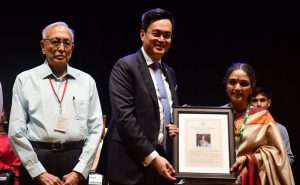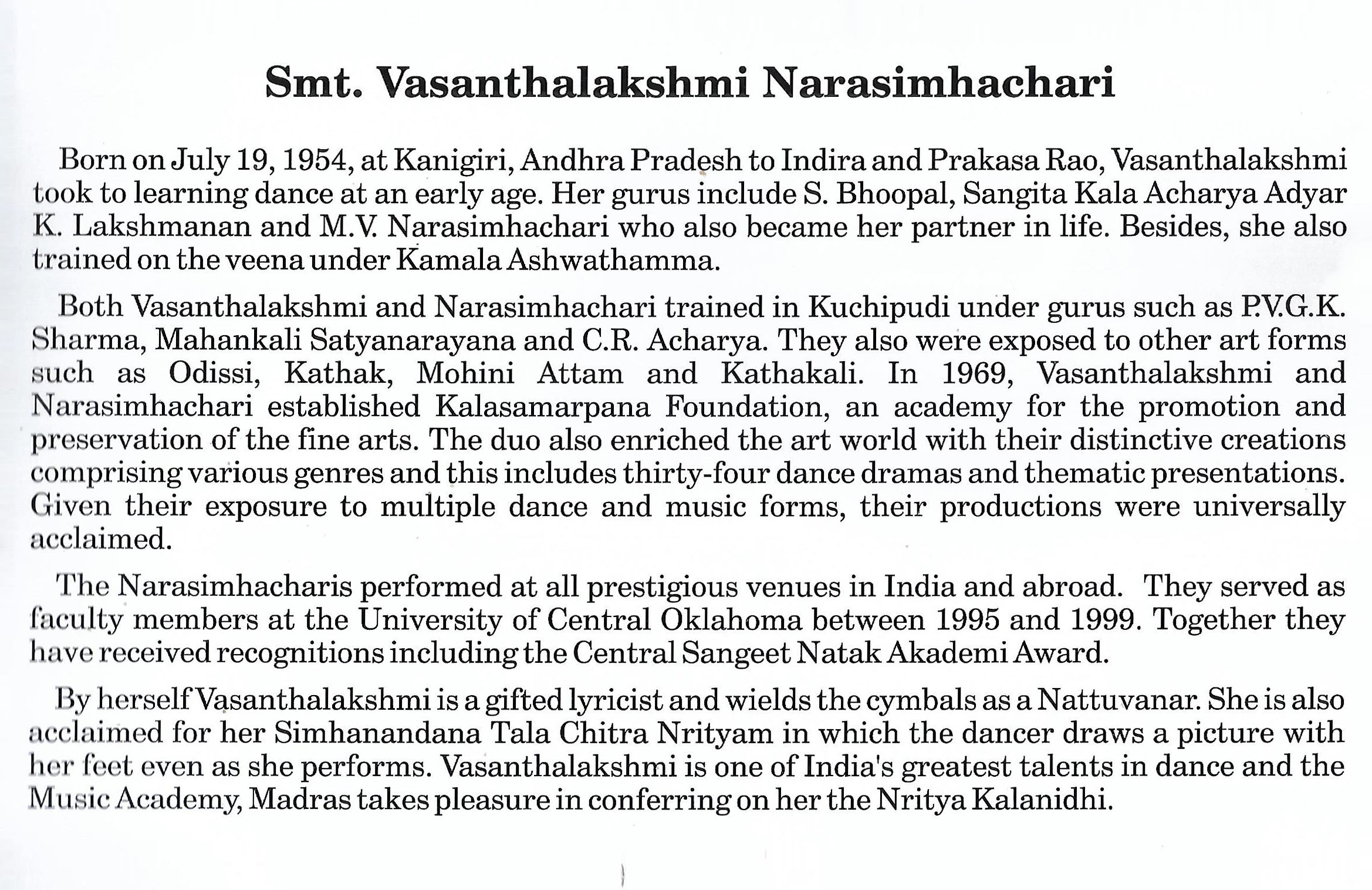
Vidushi Vasanthalakshmi Narasimhachari was conferred the prestigious Nritya Kalanidhi title and award by the Music Academy, Chennai on 3rd January 2024, during the inauguration of its 17th Dance Festival, held at the T.T. Krishnamachari Auditorium in Chennai. The medal and citation were presented to her by the chief guest Edgar Pang Tze Chiang, Consul General, Consulate General of the Republic of Singapore, Chennai.
In his inaugural address, the Consul General spoke about Singapore’s cultural links with Tamil Nadu, and described the Music Academy as a key custodian of south India’s rich cultural heritage. Felicitating the Nritya Kalanidhi awardee, he recalled that Vasanthalakshmi and her husband M.V. Narasimhachari had served the Singapore Fine Arts Society as dance tutors in the 1970s, when they had trained several dancers in Singapore and presented multicultural performances.
Earlier, N. Murali, president of The Music Academy, spoke about the dance festival and felicitated Vasanthalakshmi as one of the foremost exponents of classical dance, and stated that she and her husband had many distinctive creations to their credit through their Kalasamarpana Foundation.
In her acceptance speech, the gracious Nritya Kalanidhi described it as a significant moment in her life: “It is not Vasanthalakshmi the individual, who is being acknowledged and felicitated but Vasanthalakshmi, the artiste who has found life’s purpose in her art.”
The citation for Vasanthalakshmi Narasimhachari was read out by N. Ramji, one of the Secretaries of the Music Academy and Convenor, Dance Festival Committee.

Vidushi Vasanthalakshmi Narasimhachari presented a lecdem during the morning academic sessions of the Music Academy on 25 December 2023. You can view the presentation titled RASA – ON PURPOSE via the YouTube link below:
by S. Janaki
Vasanthalakshmi Narasimhachari’s name has become synonymous in dance with the Simhanandana tala. I vividly remember in the premiere of her presentation that she spoke about it and then took position under the spotlight on one side of the stage to execute the complex 128-beat tala while the dance was performed by her daughter Lasya. The next three avaratanams took us on a memorable experience.
The first cycle was a sloka in Sanskrit, penned by Vasanthalakshmi herself, inviting and invoking the Divine Mother for the Natya Yagna, where an offering of music, dance, and rhythm, stemming from the body, mind, and soul were offered as oblation. The second tala cycle formed the drawing of the figure of a lion on colour powder with the dancer’s feet (by Lasya Narasimhachari), where each tala angam was used to draw a particular angam of the lion’s body. The drawing was complete when the tala cycle ended, all within just two minutes! The third cycle of the tala echoed the Durga Gayatri mantra, where the dancer transcends her identity as an individual and merges with the Divine.
The spiritual journey that the audience was taken through culminated with the music ending in a crescendo, and Vasanthalakshmi ending the Tala with the ‘Kakapada’. It was an intense, sublime moment of transcendence as Vasanthalakshmi deeply immersed in the laya, seemed like a tapasvini. The Rasa experience was complete in these six magical minutes followed by absolute silence in the hall. This indelible image of Vasanthalakshmi Narasimhachari, in a way, reveals her deep sadhana and satvic personality.
Vasanthalakshmi and Narasimhachari worked together to build a life dedicated to the pursuit of excellence in classical arts. Their dancing was marked by freshness and originality though firmly grounded in tradition and classicism. When Guru Narasimhachari passed away all of a sudden in 2015, Vasanthalakshmi was shattered.
She had to complete her masters in arts from Sastra University in the next few months. The family would listen to his audio recordings every day, and Vasanthalakshmi healed through art. She studied and wrote her exams, and passed with flying colours – winning the Director Subrahmanyam Gold Medal for the best student! Vasanthalakshmi recalls: “My husband and I had learned the Simhanandini from Guru C.R. Acharya. The three of us planned to explore its potential and present it vibrantly. However, unforeseen circumstances hindered our aspirations. We continued to perform it for several years, but tragedy struck again with the sudden demise of my husband. Struggling with grief and loss, I recalled our collective dream and, with renewed determination, threw myself into working on Simhanandini.”
She is now pursuing her Ph.D in dance. Besides her passion for music and dance, Vasanthalakshmi is an extraordinary cook, a voracious reader and very fond of animals. Vasanthalakshmi Narasimhachari is also the author of Rasoham, a non-profit arts organization started in 2007, dedicated to the promotion, propagation, and preservation of arts and the art community at large. Their mission is to make art both accessible and affordable to everyone. Supporting underprivileged artists is a key objective of the charitable trust. In 2019, Vasanthalakshmi, celebrated the Golden Jubilee, Swarnanjali, of the Kalasamarpana Foundation of which she is the Director, in a grand manner. This consummate artiste blessed with all the attributes of a true ‘nartaki’ and who was her husband’s co-collaborator has now chosen to tread the solitary path of a ‘tapasvi’ – a seeker of knowledge to carry forward the artistic legacy.
VASANTHALAKSHMI NARASIMHACHARI shared some interesting insights into her life and art with S. JANAKI. Read on.
Was there music and dance in your family? Tell us about your exposure to the arts as a child.
Music and poetry played a significant role in my life and upbringing. On my maternal side, I come from the ancestral lineage of Vennelaganti Soorana, a royal poet of the Nellore Samsthanam. On my paternal side, my great-grandfather was adept at explaining the nuances of the Ramayana to such an extent that his family was referred to by the sobriquet “Ramayanam.” In our house, even normal conversations were often ‘versified’, and there would be impromptu Saval-Jawabs! My mother, Indira Prakasa Rao, was a trained Carnatic singer and violinist. She even effortlessly stepped in as the violinist for an unscheduled performance of ours! I am so fortunate that my parents recognized and encouraged my deep passion for dance and music at a young age.
What was your husband’s approach to art?
I was fortunate to become the partner in life and on stage to my third Guru, Sri M.V. Narasimhachari. With him, the pedagogy was very different from that of my earlier gurus. He would say, “Observe, be open to everything around you, choose well, and give it an aesthetically pleasing form.” His multidisciplinary skills as a choreographer, musician, composer, dancer, mridangam player, and theatre artist enriched my daily life with constant learning and exploration.
How important is research and study of theory for a dancer? Does it help in composing and choreographing?
It depends on the area of focus, whether one would like to be a performer, teacher-choreographer, or research scholar in the vast realm of Natyam. While most dance schools impart foundational theoretical knowledge, I feel that the essence of composing and choreographing emerge more from the heart than from textual understanding. There have been several dancers down the ages who may not have been well versed in Sastra, yet their performances had the profound ability to touch the soul deeply. Natyam, rooted in an oral tradition, emphasizes learning through osmosis, observation, practice, performance, and teaching. While one can be trained to excel as a dancer and even as a choreographer to some extent, the honour of being referred to as a ‘gifted’ performer or choreographer is commanded, not demanded!
How can we grasp and define the intrinsic essence of any artistic style – its core? Can transformative adjustments be introduced without compromising its essence?
Let’s start by unravelling the concept of the ‘core’. In the realm of Natyam, how do we discern a distinctive style or, delving deeper, identify variations within the same style, known as ‘Bani’? Typically, three layers enable us to recognize a style or a Bani: the physical, the articulated, and the emotional. These correspond to Angika, Vachika, and Satvika, with Aharya, or the costume, forming the foundation. These choices were not arbitrary selections of the past but were meticulously crafted and curated based on ‘Pravrtti’ — Bharata’s concept signifying ‘regional identity’.
However, what is denoted as the core transcends these phenomena; it is the noumenon—a ‘thing-in-itself’. This is the ‘Satyam,’ the essence we seek. This pursuit is the Satya-Anveshana or the quest for truth, demanding the discipline of ‘Tapasya’, a profound meditative contemplation. The mind is silent, and the internal fire is kindled through ‘tapasya’. Profound as it may sound, this process applies universally, whether to a yogi, a poet, a musician, or a dancer.
A meaningful alteration to anything can only occur when its core — ‘Satyam’ is comprehended. Throughout generations, it has been observed that only those changes that withstand the test of time endure, while others fade away like dead leaves. So, journey into the core, and allow yourself enough time. It is not a ‘fast food’ to be consumed instantaneously.
Any memorable moments in your dance journey?
To me, our journey in art has been filled with sublime moments, whether on stage during a performance or in the middle of a rehearsal. There are moments of serene introspection where I transform into a ‘Rasika’, observing my performance as if from a witness stand, embodying Sakshi bhava. In those quiet intervals, time seems to stand still, creating a profound connection with the Cosmos, where each of us becomes an integral part of the undivided whole. A sense of supreme bliss envelops me during these priceless moments of Sat-Chit-Ananda!
Of course, I can recall a few incidents too.
# Begum Parveen Sultana saw me perform as a teenager at Chandigarh for the All India Bhaskar Rao Music and Dance Conference. We stayed for many days with Kosar Sab, Founder-Director of Pracheen Kala Kendra, where we had the wonderful opportunity of listening to a host of musicians who came for their impromptu riyaz. We met the Dagar Brothers, Acchan Maharaj, Shambhu Maharaj, Birju Maharaj, and Parveen Sultana, among other greats.
As I was both young and petite, they called me ‘gudiya’ or doll. A few years later, Parveen Ji saw our performance for the Sur Singar Sansad, Bombay, when we received the ‘Singarmani’ award. I was thrilled when she walked up to me with teary eyes after the performance and said, “Now you are a young woman, not a ‘gudiya’ anymore, and your dance touched me so deeply!” I was thrilled, it was a memorable moment for me.
# After our performance of “Siva Leela” in Vijayawada, when there was some last-minute confusion about transportation, my husband and I got into a cycle-rickshaw to get back to our hotel a few streets away from the auditorium. The rickshaw puller had watched the dance drama and refused to take any payment from us, saying he felt he was taking Siva and Parvati on a procession! He was very emotional and kept chanting “Om Namah Sivaya, Hara Hara Mahadeva” all the way till we reached the hotel!
# During our dance drama “Saranam Ayyappa”, the Narada Gana Sabha auditorium resounded with “Saamiyei Saranam Ayyappa” as we lit a lamp in the balcony at the back of the hall — symbolizing the Makhara jyoti. The audience turned around to look up as the sound of the conch and bells filled the atmosphere. The devotional fervour was so palpable and it was indeed a goosebumps moment for all. In fact, a devotee in the audience, unable to go to Sabarimalai, said he felt a sense of fulfilment after seeing the dance drama.
How do you feel about receiving the NRITYA KALANIDHI Award from the Music Academy?
I feel grateful to be celebrated as an artist. When I think of my husband and his monumental work, every creation that offers a masterclass in choreography and presentation, my head rises with pride. And I welcome this award as something long overdue to him! Thank You, Music Academy!
Here is the link to an article on Vasanthalakshmi Narasimhachari published in The Hindu.